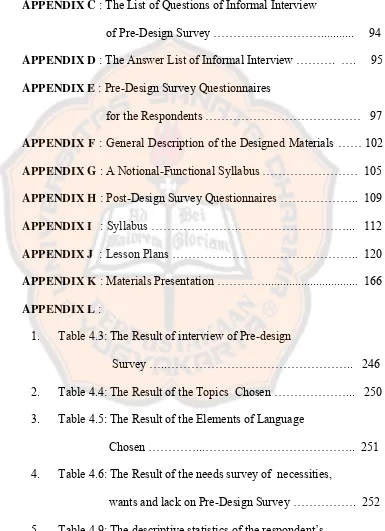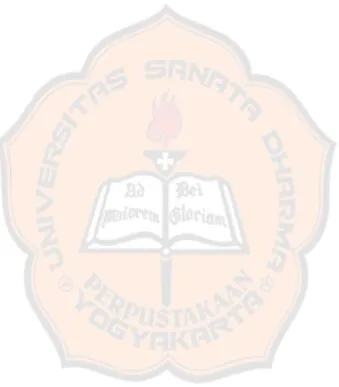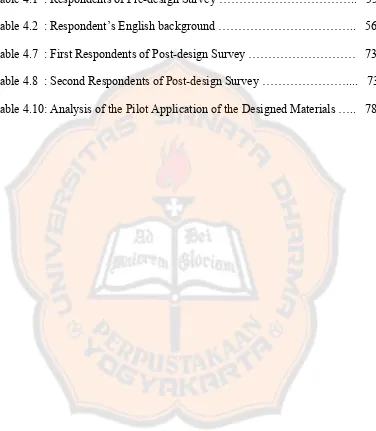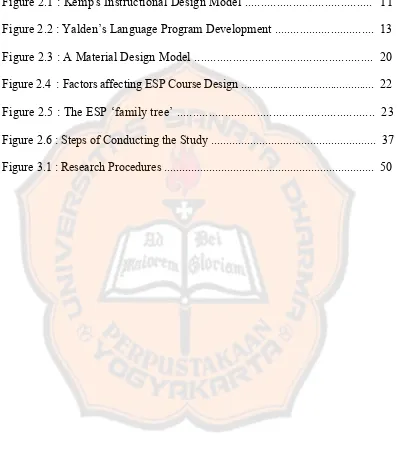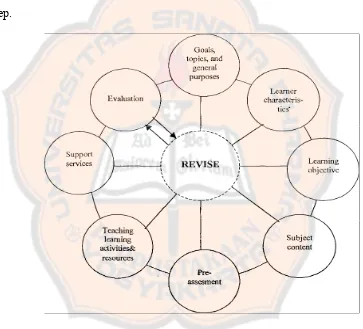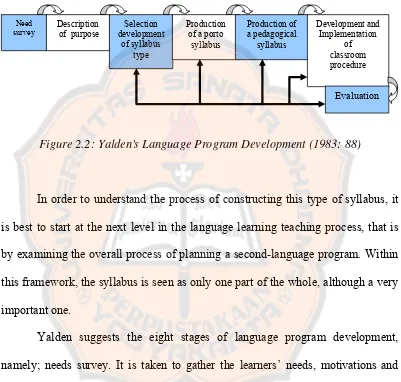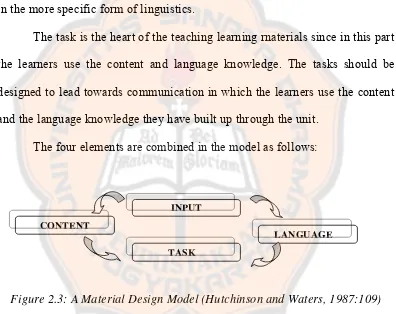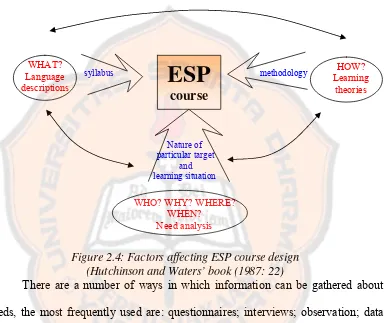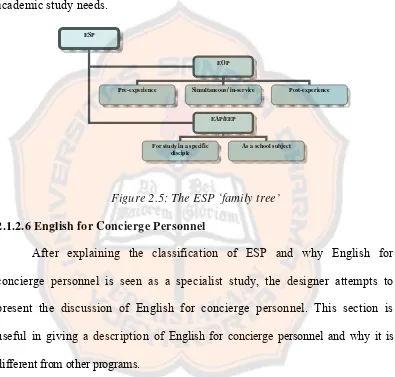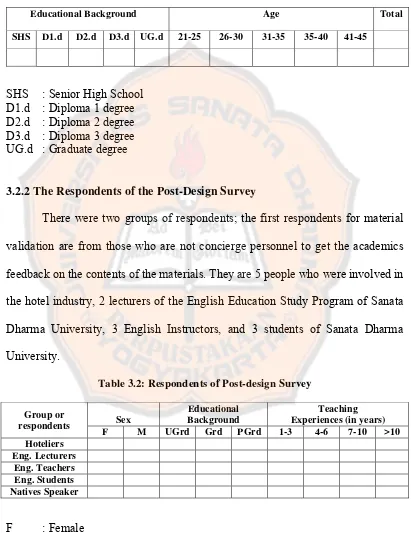DESIGNING A SET OF INTEGRATED ENGLISH
INSTRUCTIONAL MATERIALS
FOR CONCIERGE PERSONNEL
A THESIS
Presented as Partial Fulfillment of the Requirements
to Obtain the Sarjana Pendidikan Degree in English Language Education
By
YOHANA ANITA FEBRIANI
ENGLISH LANGUAGE EDUCATION STUDY PROGRAM
DEPARTMENT OF LANGUAGE AND ARTS EDUCATION
FACULTY OF TEACHERS TRAINING AND EDUCATION
SANATA DHARMA UNIVERSITY
YOGYAKARTA
2007
Student Number : 011214100
DESIGNING A SET OF INTEGRATED ENGLISH
INSTRUCTIONAL MATERIALS
FOR CONCIERGE PERSONNEL
A THESIS
Presented as Partial Fulfillment of the Requirements
to Obtain the Sarjana Pendidikan Degree in English Language Education
By
YOHANA ANITA FEBRIANI Student Number : 011214100
ENGLISH LANGUAGE EDUCATION STUDY PROGRAM
DEPARTMENT OF LANGUAGE AND ARTS EDUCATION
FACULTY OF TEACHERS TRAINING AND EDUCATION
SANATA DHARMA UNIVERSITY
YOGYAKARTA
2007
STATEMENT OF WORK’S ORIGINALITY
I honestly declare that this thesis which I wrote does not contain the works or part
of the works of other people, except those cited in the quotations and
bibliography, as a scientific paper should.
Yogyakarta, 21 February 2007
The writer
Yohana Anita Febriani
ABSTRACT
Febriani, Yohana Anita. 2007. Designing a Set of Integrated English Instructional Materials for Concierge Personnel. Yogyakarta: Sanata Dharma University.
This research aims at designing a Set of Integrated English Instructional Materials for Concierge Personnel. The principle of integrated materials guides the writer in designing these materials. It was based on the learners’ needs, the concierge personnel, who have to equip themselves with good English skills, not only in speaking but also in writing, reading and listening.
Concierge personnel usually remain in the front office that directly deal with guests. As personal guides, they represent the hotel. Important skills that need to be acquired by hotel staff are to serve guests professionally and to be able to communicate in English.
Based on the interview, most of them did not receive basic English lesson, because they did not learn English formally in schools, therefore their vocabulary mastery also varies. They learnt English from their own daily experience and habits while accompanying guests. Most of the time they spoke English incorrectly because they just translate Indonesian sentences into English without considering the grammar and correct pronunciation. It was not rare for them to use gestures to explain what they wanted to say. Most of them have difficulties of finding correct expressions when they produced words without producing sentences. Their ability and knowledge to enable them to speak good English still needs improvement.
This research was conducted in order to answer two research questions, first is how a set of instructional English speaking materials for concierge personnel is designed and the second research question is what the designed materials look like.
In order to answer the first problem, the writer applied seven steps of the instructional design model which were the combination of Kemp and Yalden’s instruction design models, namely conducting needs’ survey; formulating the goals, topics and general purposes; selecting the type of syllabus and developing the syllabus; selecting subject content; developing the materials; validating the materials and revising the materials.
The writer conducted two survey researches. First, the pre-design research, in the form of questionnaires in order to collect as much information as possible from the learners about their necessities, lacks and wants.
The second survey was post-design survey, to achieve the feedback to gather input in the form of criticism and suggestions on the designed materials. There were three types of methods. The first method was in the form of closed form questions of questionnaires for concierge personnel and non-concierge personnel which was meant to gather academically and non-academically feedback on the designed materials. The second method was in the form of points of agreement, which were computed using descriptive statistics. The statistical data showed the mean is in the points 4.80, it means, the designed materials is good and already fit the learner’s needs as concierge personnel. The third method
used by writer in validating the materials was holding preliminary application. The writer directly proved that the learners were motivated to learn the designed materials.
After improving the designed materials, the writer presented the final set of the materials. This was to answer the second research question. The materials consist of eight units. Each unit contains eight sections: preview, speaking activities, writing activities, listening activities, reading activities, language focus, speech works and vocabulary bank. All was prepared integratedly, to gain and develop communicative English skills in speaking, listening, writing and reading.
ABSTRAK
Febriani, Yohana Anita. 2007. Designing a Set of Integrated English Instructional Materials for Concierge Personnel. Yogyakarta: Sanata Dharma University.
Penelitian ini bertujuan untuk membuat sebuah kumpulan materi pengajaran bahasa Inggris yang menitikberatkan pada pengembangan kemampuan berbicara, mendengar, membaca dan menulis bagi anggota-anggota concierge. Prinsip-prinsip pengajaran itulah yang menuntun penulis untuk membuat kumpulan materi ini. Isi dari materi ini, didasarkan pada kebutuhan anggota-anggota concierge, yang mana mereka harus membekali dirinya dengan kemampuan berbahasa Inggris secara komunikatif, baik dan benar, tidak hanya kemampuan dalam berbicara akan tetapi juga kemampuan dalam menulis, membaca dan mendengar.
Anggota-anggota concierge merupakan bagian dalam Front Office Department sebuah hotel yang melakukan kontak langsung dengan tamu. Sebagai pemandu pribadi atau personal guide, menjadikan mereka sebagai wakil sebuah hotel. Oleh karenanya kemampuan penting yang harus dikuasai oleh seorang pegawai hotel adalah kemampuan untuk melayani tamu secara profesional dan kemampuan untuk berkomunikasi dalam bahasa Inggris.
Berdasarkan tanya jawab yang dilakukan dengan anggota-angggota concierge, kebanyakan dari mereka tidak belajar dasar-dasar bahasa Inggris secara formal lewat jalur pendidikan, sebagai hasilnya perbendaharaan kata mereka sangat bervariasi. Meraka belajar bahasa Inggris dari pengalaman sehari-hari dan faktor kebiasaan saat melayani tamu. Sering sekali mereka tidak berbahasa Inggris secara benar dalam arti kata, mereka hanya menterjemahkan kalimat dalam bahasa Indonesia kedalam bahasa Inggris tanpa mempertimbangangkan pola tata bahasa yang benar dan pengucapan yang benar. Jadi, tidak heran jika mereka mengggunakan gerak isyarat untuk menjelaskan apa yang mereka ingin katakan. Sebagian besar dari mereka menemukan kesulitan untuk memilih ekspresi-ekspresi yang tepat untuk membuat sebuah kalimat. Oleh karena itu, kemampuan dan pengetahuan mereka tentang bahasa Inggris masih perlu untuk diperbaiki dan dikembangkan.
Penelitian ini dilakukan untuk menjawab dua pokok permasalahan, pokok permasalahan yang pertama adalah bagaimana sebuah kumpulan materi pengajaran bahasa Inggris yang menitikberatkan pada penggabungan materi yang mengacu pada perkembangan kemampuan berbicara, mendengar, membaca dan menulis bagi anggota-anggota concierge dibuat dan pokok permasalahan yang kedua adalah bagaimana bentuk dari materi pengajaran itu sendiri.
Untuk menjawab pokok permasalahan yang pertama, penulis menerapkan tujuh langkah-langkah model pengajaran yang merupakan gabungan dari model pengajaran dari Kemp and Yalden. Tujuh langkah-langkah tersebut adalah melakukan survey kebutuhan responden; menetapkan tujuan khusus pengajaran, menentukan topik dan tujuan umum pengajaran; memilih dan mengembangkan silabus yang cocok untuk pengajaran; memilih isi materi pengajaran;
mengembangkan meteri pengajaran; mengevaluasi materi pengajaran dan merevisi materi pengajaran.
Dalam penelitian ini, penulis mengadakan dua buah survey. Survey yang pertama dilakukan sebelum membuat materi pengajaran, hal ini dilakukan dengan tujuan untuk mengumpulkan informasi sebanyak mungkin dari responden tentang kebutuhan, kelemahan dan keinginan responden.
Survey yang kedua dilakukan setelah materi dibuat, dengan tujuan untuk mengevaluasi materi yang telah disusun. Hasil dari survey ini adalah dalam bentuk kritik dan saran. Ada tiga buah metode yang diterapkan untuk mengevaluasi materi tersebut. Metode pertama dalam bentuk kuesioner tertutup yang berisi pertanyaan-petanyaan singkat yang ditujukan untuk anggota-anggota concierge maupun bukan anggota-anggota concierge, untuk mendapatkan hasil secara akademis dan non-akademis. Metode yang kedua dalam bentuk angka, yang didapat dari perhitungan secara statistik. Hasil data dari perhitungan statistik menunjukkan angka rata-rata 4.80 yang berarti bahwa materi pengajaran yang telah disusun adalah baik dan sudah memenuhi kebutuhan anggota-anggota concierge. Mengaplikasikan materi yang telah disusun secara langsung kepada responden kedalam suatu proses pengajaran adalah metode ketiga dalam mengevaluasi materi. Hal ini dilakukan penulis guna membuktikan bahwa materi yang telah disusun adalah materi yang benar-benar sesuai dengan ketutuhan anggota-anggota concierge.
Setelah memperbaiki materi yang telah disusun, penulis membuat hasil akhir dari materi tadi. Hal ini dilakukan guna menjawab pokok permasalahan yang kedua dalam pokok permasalahan. Hasil akhir dari materi ini terdiri dari delapan unit pengajaran. Setiap unit terdiri dari delapan bagian yaitu preview, speaking activities, writing activities, listening activities, reading activities,
language focus, speech works and vocabulary bank. Kesemuanya dibuat untuk
mengembangkan kemampuan berbahasa inggris secara komunikatif dalam berbicara, mendengar, menulis dan membaca.
ACKNOWLEDGEMENTS
I dedicated this thesis, especially, to my real Saviour Jesus Christ, who
keeping me alive and giving me the strength to dare to step forward and Hail
Mary, the mother, who blessing me with her prayers and graces that filled my
soul.
I would also like to thank FX. Ouda Teda Ena, S.Pd., M.Pd., my major
sponsor, for all his precious time in guiding me during the process and his
commitment to help me finish my thesis. Then, I would like to thank Henny
Herawati, S.Pd., M.Hum., my co-sponsor, who has helped me in correcting it
and giving suggestions to achieve the best result.
I take this opportunity to express my gratitude to Sr. Maryrose FCJ and
Sr. Margaret FCJ and Fr. “Big” John OMI for all their kindness and
willingness in giving me suggestions and advice that is so precious not only for
my thesis, but also for my life; they are angels for me.
My deepest gratitude goes to my family, especially, Simbah Putri,
Saimahand the late Simbah Kakung, H.J. Saparin Oetojo, for taking care of me
and giving all that they have. To be with them, all experiences are miracles. Also,
for my late Mommy and Dad for always accompanying me during my bad and
good times, I believe. To Pak Edi and Bu Fin and family, who have supported me
in many things.
My Ibu-Suster, Sr. Gratia Sunaringsih OP, for her smile and hugs, she
is a present from God for me. My Bapak-Romo, Rm. Endro Wijayanto Pr., for
his kindness and teaching me how to be a wise person. They are lively spirited
that always kept me awake. My thanks go to Rm. Sapto Nugroho Pr., Rm.
Gregorius Heliarko SJ and Rm. A. Wahadi Pr., Mas Pras for supporting me in
many things.
My special gratitude goes to Amanjiwo family, especially Pak Agus, who
gave me opportunities to do a research there. Mba Tari, for taking care of all the
regulations and for making it easier and faster. Pak Anton and Mba Upik, for his
precious time and his best suggestion for my thesis. Moreover, for all my friends
in concierge personnel; Mas Bambang, Mas Topo, Mas Poyo, Mas Udin, Mas
Wisnu, Mas Rohmad, Mas Jack, Mas Fauzi, Mas Hanafi, Mas Supri, Mas
Muji, Mas Agusta, and Mas Kirno as the respondents for my research.
My great thank also goes to all my friends in PBI 2001, and also for
Flamboyan Crew: Munika, Calista, Mba Ningrum ‘BJ’, ,Yuni, Yenny
Ganjuran, Fitri, Melly, Ayu, Putu, Resti, Mba Tin, Bonita, Eta for always
supporting me to finish my thesis soon.
My endless thanks go to Dirga, who showed me that friendship and
companionship are beautiful.
Finally, I would also like to thank everyone that I cannot name personally.
Yohana Anita Febriani
TABLE OF CONTENTS
Page
TITLE PAGE ……… i
APPROVAL PAGE ……….…… ii
PAGE OF BOARD OF EXAMINERS ……….. iii
STATEMENT OF WORK’S ORIGINALITY ………. iv
ABSTRACT... v
ABSTRAK ………..………… vii
ACKNOWLEDGEMENTS ……….……… ix
TABLE OF CONTENTS ……….. xi
LIST OF TABLES ……….……… xvi
LIST OF FIGURES ……….. xvii
CHAPTER I. INTRODUCTION 1.1 Research Background ……….. 1
1.2 Problem Identification ………. 3
1.3 Problem Limitation ……….. 4
1.4 Problem Formulation ………... 4
1.5 Research Objectives ………. 5
1.6 Research Benefits ………. 5
1.7 Definition of Terms ……….. 6
CHAPTER II. LITERATURE REVIEW 2.1 Theoretical Description ... 10
2.1.1 Instructional Design Models ………. 10
2.1.1.1 Kemp’s Instructional DesignModel ……… 11
2.1.1.2 Yalden's Model ………. 13
2.1.2 English for Specific Purposes (ESP) ……… 16
2.1.2.1 The Definition of ESP ……….. 16
2.1.2.2 The Characters of ESP ……… 17
2.1.2.3 Syllabus ……….……. 18
2.1.2.4 Designing ESP ... 20
2.1.2.5 Classification of ESP ... 24
2.1.2.6 English for Concierge Personnel ... 24
2.1.3 Communicative Language Teaching ... 25
2.1.3.1 The Characteristics of Communicative Language Teaching ... 25
2.1.3.2 The Goal of Communicative Language Teaching ….. 26
2.1.3.3 The Communicative Language Teaching involves the communicative activities ... 27
2.1.3.4 The Learners’ Main Role in CLT ... 28
2.1.3.5 The Teacher's Main Role in CLT ... 29
2.1.4 Integrated Language Learning ... 30
2.1.4.1 Two forms of Integrated-Skills Instruction ... 31
2.1.4.1.1 Content-based Instruction ... 32
2.1.4.1.2 Task-Based Instruction ... 33
2.1.4.2 Advantages of the Integrated-skills Approach ………….. 33
2.2 Theoretical Framework …………..………. 34
CHAPTER III RESEARCH METHODOLOGY
3.1 Research Method ... 39
3.2 Research Respondents ... 43
3.2.1 The Respondents of the Pre-Design Survey ... 43
3.2.2 The Respondents of the Post-Design Survey ... 44
3.3 Research Setting ... 45
3.4 Research Instruments ... 46
3.4.1 Questionnaire ... 46
3.4.2 Interview ... 46
3.5 Data Gathering ... 47
3.6 Data Analysis ... 47
3.6.1 Material Validation ... 48
3.6.2 Preliminary Application ... 49
3.7 Research Procedure ... 50
3.7.1 Pre-design Survey ... 50
3.7.2 Designing Materials ... 50
3.7.3 Post-design Survey ... 52
CHAPTER IV RESEARCH FINDINGS AND DISCUSSION 4.1 The Results of the Research ……….……….……… 54
4.1.1 The Results of Pre-design Survey ……….... 54
4.1.1.1 Conducting Needs Survey ………... 54
4.1.1.1.1 The Respondents of the Needs Survey in Pre-design Survey ……….... 55
4.1.1.1.2 The Results of Needs Survey ………... 55
4.1.1.2. Stating Goals, Topics and Objectives …………... 59
4.1.1.2.1 The Goal ………... 59
4.1.1.2.2 The Topics ……….. 59
4.1.1.2.3 The Objectives ……… 60
4.1.1.3 Selecting and Developing the Syllabus ………... 68
4.1.1.4 Selecting Subject Content ……… 69
4.1.1.5 Selecting Teaching / Learning Activities ……… 71
4.1.1.6 Evaluating ……… 72
4.1.2 The Results of Post-design Survey ………... 72
4.1.2.1 The Respondents of the Need Survey in Pre-design Survey ……… 73
4.1.2.2 Data Presentation ………. 74
4.1.2.2.1 Descriptive Statistics of Respondent’s Opinions on the Designed Materials ……..……….. 74
4.1.2.2.2 The Respondents’ Comments and Suggestions on the Designed Materials ……… 76
4.1.2.2.3 The Result of Preliminary Application ……… 77
4.2 Revising the Materials ……….. 73
CHAPTER V CONCLUSIONS AND SUGGESTIONS 5.1 Conclusions ………. … 81
5.2 Suggestions ………... 85
BIBLIOGRAPHY ……….. 88
APPENDICES ……… 92
APPENDIX A : Research Permission Letter ……… 92
APPENDIX B : Amanjiwo Official Statement ………. 93
APPENDIX C : The List of Questions of Informal Interview of Pre-Design Survey ………... 94
APPENDIX D : The Answer List of Informal Interview ………. …. 95
APPENDIX E : Pre-Design Survey Questionnaires for the Respondents ……… 97
APPENDIX F : General Description of the Designed Materials …… 102
APPENDIX G : A Notional-Functional Syllabus ……… 105
APPENDIX H : Post-Design Survey Questionnaires ……….. 109
APPENDIX I : Syllabus ……….………... 112
APPENDIX J : Lesson Plans ……….. 120
APPENDIX K : Materials Presentation …………... 166
APPENDIX L : 1. Table 4.3: The Result of interview of Pre-design Survey …..……….. 246
2. Table 4.4: The Result of the Topics Chosen ………... 250
3. Table 4.5: The Result of the Elements of Language Chosen …………...……….. 251
4. Table 4.6: The Result of the needs survey of necessities, wants and lack on Pre-Design Survey ………. 252
5. Table 4.9: The descriptive statistics of the respondent’s
opinion on the Designed materials ………. 252
6. Figure 4.1: The process of deciding units in
the materials ……….. 255
LIST OF TABLES
Page
Table 4.1 : Respondents of Pre-design Survey ……….. 55
Table 4.2 : Respondent’s English background ……….. 56
Table 4.7 : First Respondents of Post-design Survey ……… 73
Table 4.8 : Second Respondents of Post-design Survey ……….... 73
Table 4.10: Analysis of the Pilot Application of the Designed Materials ….. 78
LIST OF FIGURES
Page
Figure 2.1 : Kemp's Instructional Design Model ... 11
Figure 2.2 : Yalden’s Language Program Development ... 13
Figure 2.3 : A Material Design Model ... 20
Figure 2.4 : Factors affecting ESP Course Design ... 22
Figure 2.5 : The ESP ‘family tree’ ... 23
Figure 2.6 : Steps of Conducting the Study ... 37
Figure 3.1 : Research Procedures ... 50
CHAPTER I INTRODUCTION
In this study, the writer intends to design a set of Integrated English
Instructional Materials for Concierge Personnel.
In order to achieve the purpose of the above study, the first chapter
presents a brief description of the background, problem identification, problem
limitations, problem formulations, research objectives, research benefits and
definition of terms.
1.1 Background
Since Indonesia is known as an incredible mosaic of sights, sounds and
impressions, as cited in Jakarta, Java- kini magazine (February 2006), Indonesia
has become a pleasurable heaven to visit by tourists (Soegondo, 2006). However,
nowadays, terrorism and bomb threats in many public areas in Indonesia,
especially in tourist resorts such as beaches, cafés, hotels and malls, have resulted
in many foreigners losing their interest in visiting or staying in this heavenly land.
Kompas (March 2006) says that the situation has made development in tourism
decrease. The problem, of course, causes bad effects in so many sectors, mostly,
the sectors that directly deal with tourism and the situation has become a
challenge for everybody.
A hotel, as one facility that supports tourism needs more professional as
well as better management and services than before. By improving the
management and services which requires professional staff, Indonesia may
interest more tourists, especially foreign tourists in visiting and staying longer in
its tourist resorts. Therefore, one important skill that needs to be acquired by hotel
staff is to serve guests professionally and the ability to communicate in English.
This is supported by the annual data from the Province Tourism Department that
most of the tourists visiting Indonesia can communicate in English well.
Therefore, everybody has to equip themselves with English if they want to
improve and develop science, technology, art and culture to maintain a
relationship with other countries (Indonesian Education and Culture Department,
1994:2)
This material is prepared for concierge personnel to develop their English
skills. There is no special supplementary book to support their work in the market.
According to Bambang, the concierge captain of Amanjiwo resort in Borobudur
(interview, 20 June 2006) concierge personnel are persons who have the same job
and the same responsibility as a personnel guide. His job is guiding the way,
giving information and explaining about the tourism attractions (Silih, 2002: 7).
They are important persons to represent the hotel, so, they have to be professional
and qualified in communicating in English. As a result, concierge personnel, have
to equip themselves with good English skills.
A good command of English contributes to the creation of a pleasant
atmosphere between the guests and the hotel staff. Such a pleasant atmosphere
maintains the relationships, achieves a measure of cooperation, keeps the channels
As concierge personnel who deals in hospitality, learning a language is not
only learning a set of grammatical structures but also a set of functions.
Furthermore, language is used to communicate with people and to cause things to
be done, to describe and explain events. To communicate with people, to cause
things to be done, to describe and explain events are among the functions of
language (Halliday, 1978). In conclusion, being able to use language
appropriately in communication means that the hotel staff are likely to be able to
create a pleasant atmosphere, which maintains the relationship with the guests.
1.2 Problem Identification
Concierge personnel usually remain in the front office that directly deals
with guests. As personal guides, they represent the hotel. According to the
interview most of them do not receive basic English lessons, because they did not
learn formally through special English schools, therefore their vocabulary mastery
also varies. They learnt English from their own daily experience and habitually
while accompanying guests. Sometimes they speak English according to their
own version and sometimes the way they speak is just translating Indonesian
sentences into English ones without considering grammar and correct
pronunciation. It is not rare for them to use gestures to explain what they want to
say. Most of them have difficulty finding correct expressions when they produce
words without producing sentences. Their ability and knowledge to enable them
to speak good English still needs improvement. One example is leaving a sentence
course, which emphasizes the needs of the learners to acquire the functions of
language, should be established. This research, nevertheless, concerns a design for
integrated materials based on learners’ needs to meet guests’ demands for English
proficiency as a personal guide.
1.3 Problem Limitation
A hotel company has a complex organization of management.
Nevertheless, one division, which plays an outstanding role, is that of the hotel
front office, which consists of the front office manager, desk representative, night
manager, cashier, reservationists, telephone operator, bell-boy and especially,
concierge personnel which only exist in five star hotels as personal guides (Foster,
1992: 22). However, the main focus of the study is only on the concierge
personnel, because they, as personal guides, convey personality of the hotel to the
guests and handle the guests’ needs during their stay. Therefore, it is necessary for
them to acquire sufficient communication ability.
The language used by the concierge personnel is one important factor in
communication. This is due to the concierge personnel duties, which directly deal
with the public as hotel guides.
The writer chooses integrated English instructional materials, according to
their needs, for the concierge personnel who have to equip themselves with good
English skills, not only in speaking but also in writing, reading and listening.
1.4 Problem Formulation
Based on the background of the study, there are two research questions
1. How a set of instructional English speaking materials for concierge
personnel in five stars hotel is designed?
2. What do the designed materials look like?
1.5 Research Objectives
This study is conducted in order to find out how a set of integrated English
instructional materials for concierge personnel is designed. All the theories
presented in Chapter II are explained, in order to answer the first question. The
second objective is to answer the second question which asks what a set of
integrated English instructional materials for concierge personnel will look like.
1.6 Research Benefits
This designed material is intended to give some benefits to:
1. Concierge personnel
The result of the design may become one of the sources of
integrated English instructional materials for concierge personnel. These
designed materials may help them to learn English more easily and to
know the simple daily expressions in order to be able to communicate with
foreign guests.
2. Tourism Academy Students
The result of the design may become one of the sources of
integrated English instructional materials for Tourism Academy Students.
The result of this designed material may also help English
instructors to teach integrated skills to other concierge personnel at other
resorts. They will have a set of instructional materials that can be used as a
guidance book in teaching-learning activities.
4. Other designers
This designed material will also give information to those who are
interested in designing English materials. It may be used as a supplement
book to do other designs.
1.7 Definition of the Terms
To make the design clear and avoid ambiguous interpretations, some
important terms are defined as follows:
1. Design
The Oxford Advanced Learner’s Dictionary (Hornby, 2000: 340)
defines “to design” as the art or process of deciding how something will
look, work, etc., especially by making plans or drawing models of it. It
also means to think and plan a system.
In this thesis, design, means creating a new set of materials that fits
the learners’ needs based on the learning objectives or target language.
2. Instructional Materials
Instructional materials mean a set of units, which are used by the
teacher or instructors and the learners as the focus of discussion in the
In this thesis, instructional materials mean designed materials that
contain a set of information, ideas, pictures, games, questions that will be
used in teaching and learning activities, inside and outside the class, which
support the target language.
3. Concierge
The Longman Dictionary of English Language and Culture (2002: 264)
concierge as a person working in a hotel who looks after the special needs
of the guests. The Dictionarie de la langue francaise (Arifin and
Soemargono, 2001: 196) defines concierge as a guard or a person who
works in a big company and/or his characteristic is talking. While
Bambang (interview, 20 June 2006) bell captain of Amanjiwo defines,
concierge as a person who works in a hotel whose jobs are to pick up and
drop guests’ luggage, and drive them by car to the tourism resorts.
In this thesis, concierge, means a person who works in a hotel and
whose jobs are picking up from and dropping off to the airport, guests.
They also handle guests’ luggage and their most important job is handle
guests as personal guides when they visit tourism resorts.
6. Personal Guide
Warni (2004) defines a personal guide as a person who is hired by
a guest personally to show him/her the way to different places. It means
In this thesis, personal guide, means a person who works as guests’
assistant, who accompanies guests to tourism destinations, and explains
about the places of interest and the potential things about surrounding area.
7. Integrated Materials
The Integrated Materials (Enright and McCloskey, 1988) serves as
a basis for the integrated curriculum. This model has seven basic
research-based assumptions. Language is best learned: (1) collaboratively,
involving students working with both peers and adults (Ramírez, 1991;
Brumfit, 1984; Goodlad, 1984); (2) in a socially supportive environment
(Ventriglia, 1982); (3) in a holistic manner, integrating reading, writing,
listening, and speaking; and integrating language and content (Rigg, 1991;
Goodman, Bird, and Goodman, 1991); (4) when new learning is built
upon, and takes advantage of student's previous cultural and learning
experiences (California State Department of Education, 1987); (5) when
teachers develop curriculum around student interests (Moring, 1986); (6)
when students feel ownership of classroom projects and experiences
(Cummins, 1989); and (7) when teachers provide a wide variety of
materials, instructional strategies, and ways for students to participate
(First et al., 1991; Hawkins, 1973. The Webster’s New College Dictionary
(Merriam, 1957: 437) defines integrated materials as unite or become
united to form a complete or perfect whole; unify. The Oxford Advanced
Learner’s Dictionary (Horby, 1989: 651) defines integrated materials as
instructional materials that cover all four skills of language (Richards and
Rogers, 1988: 64)
In this thesis, integrated materials mean a set of instructional
materials that develop learners’ English skills, listening, reading, speaking
and writing and link topics, to develop their language component in
CHAPTER II THEORETICAL REVIEW
This chapter presents the description of the theories which underlie this
study. This chapter is divided into two main areas, namely, theoretical description
and theoretical framework. Theoretical description presents the underlying
theories related to designing a set of Integrated English Instructional Materials for
Concierge Personnel. Theoretical framework describes the framework based on
theoretical description that has been discussed.
2.1 Theoretical Description
In theoretical description, the writer presents the theory of Instructional
Design Models, English for Specific Purposes (ESP), Communicative Language
Teaching (CLT) and Integrated Language Instructions.
2.1.1 Instructional Design Models
In order to intelligently relate all elements of the instructional program,
there are many instructional design models, which are used to support the
teaching and learning activities of the students successfully, as a system approach.
However, in this study the writer refers to Kemp's (1977: 9) and Yalden's
(1983:88) models to develop the materials. The writer combines these two models
to design the integrated English instructional materials for the concierge
personnel. Since they have their own strengths and weaknesses, hopefully these
two Instructional design models support and complete each other.
Kemp’s instructional design model is a flexible process and there is an
interdependence among the elements; decisions relating to one may affect others.
We can begin with whichever element we are ready to and then move back and
forth to other steps. The sequence and order are our choice (Kemp, 1977:9). While
in Yalden’s instructional design model, she states the possibility to include
consideration of socially appropriate and communicative use of language, as well
as linguistic structure and general usage (Yalden, 1987: 85).
She uses a communicative syllabus since Yalden’s instructional design
model is to ensure that the learners acquire the ability to communicate in a more
appropriate and efficient way (Yalden, 1987:86)
2.1.1.1 Kemp’s Instructional DesignModel
Kemp (1977: 6-8) states that the system approachinvolves the development
of an overall plan, incorporating the interrelated parts of an instructional process in
a sequential pattern. When problem solving is applied to instructional planning, the
term of instructional technology which contains resources of instruction and
materialis used. It means the systematic design of instruction, based on knowledge
of the learning process and on communications theory, taking into consideration as
many factors and variables of the particular situation as possible, so that successful
learning will result. Besides, something that is more important is understanding the
term as the process of systematic planning, that establishes a way to examine an
instructional problem, needs and sets a procedure for solving them, then evaluates
According to Kemp (1977: 8), an instructional design plan is designed to
answer three questions, which may be considered the essential elements. They are:
something that must be learnt and it deals with the objectives of the program, then,
procedure and resources which work best to reach the desired learning level, it deals
with activities and resources, next is evaluation about the required program.
The figure 2.1 illustrates the relationship of each step in the plan to the other
step.
Figure 2.1: Kemp's Instructional Design Model (Kemp, 1977: 9)
Kemp (1977: 8) suggests eight steps that are included in the instructional
design. The eight steps are: first are considering goals, a goal means something
those goals. Next steps is listing the topics, topics are usually sequenced according
to logical organisation from simple to complex or from concrete to more abstract
level. After that, stating the general purpose for teaching each topic is needed.
Second, enumerate the important characteristics of the learners for whom the
instruction is to be designed. The information can be obtained from students’
cumulative record and from consultations with other teachers, students’ counsellors
and adviser.
Third, specify the learning objectives to be achieved in terms of
measurable students’ behavioural outcomes. List the subject content that
supports each objective is the fourth step. Continued with developing
pre-assessments to determine the students’ background and presenting the level
knowledge about the topic as the fifth step and select the teaching/learning
activities and instructional resources that will treat the subject content so
students will accomplish the objectives as the sixth step of Kemp’s models.
It is important to co-ordinate the support services as the seventh step
and the last is evaluating of learners' learning in terms of their
accomplishments of objectives, with a view to revising and revaluating any
phases of the plan that need improvement.
2.1.1.2 Yalden's Model
Yalden suggests the design of a communicative syllabus that considers
the communicative needs of the learning. It means the syllabus is designed for
describing a classroom as in real situation where the language is used. The
the linguistic content to be included in it. The teacher has to ensure that the
learners acquire the ability to communicate in a more appropriate and efficient
way (1987: 86).
Need survey
Description of purpose
Selection development
of syllabus type
Production of a porto
syllabus
Production of a pedagogical
syllabus
Development and Implementation
of classroom procedure
Evaluation
Figure 2.2: Yalden's Language Program Development (1983: 88)
In order to understand the process of constructing this type of syllabus, it
is best to start at the next level in the language learning teaching process, that is
by examining the overall process of planning a second-language program. Within
this framework, the syllabus is seen as only one part of the whole, although a very
important one.
Yalden suggests the eight stages of language program development,
namely; needs survey. It is taken to gather the learners’ needs, motivations and
characteristics of learners in order to establish realistic and acceptable objectives.
Next, is description of purpose to be prepared in terms of student characteristics and
student skills on entry to and on exit from the program. Selection or development of
syllabus type in terms of production of a porto syllabus and physical constraint on
The proto-syllabus description of language and language use to be covered
in the program are the third and fourth stage which chain each other. The
pedagogical syllabus development of teaching, learning and testing approaches
which include the development of teaching materials and development of testing
sequence and decision on testing instruments is considered as the fifth stage of
Yalden’s.
The sixth stage contains development of classroom procedures as the first
one which includes selection of exercise types, teaching techniques and preparation
of lesson plan and preparation of weekly schedules. The second one of the sixth
stage is teacher training, that is briefing or workshops on principles, desired
outcome and exploitation/creating of teaching material.
Evaluation which is undertaken in its learners, program and teaching is
important in Yalden’s. The last but not least is recycling stage in Yalden’s, those are
congruence or “fit” between goals set and learners’ performance is determined,
content is reassessed and materials also methodological procedures are revised.
According to her, to develop a syllabus we need to consider
components of communicative syllabus as follows: the purposes, the setting,
the roles, the communicative events, the language functions, the notions, the skills
involved discourse and rhetorical skills, the varieties, the grammatical contents
and the lexical contentsthat is needed.
The main point of Yalden’s model is the emphasis on needs’ analysis and
develop of communicative syllabus. The developing of a communicative syllabus is
The teacher is a guide of the teaching and learning process while learner needs,
wants and desires are the focus of the models (Yalden 1987: 89).
2.1.2 English for Specific Purposes (ESP)
The writer presents the definition of ESP, the criteria of ESP, the syllabus
in ESP, ESP materials design model, and classification of ESP, the definition of
English for Concierge Personnel in order to give an overall view of how English
for the concierge personnel becomes part of ESP.
2.1.2.1 The Definition of ESP
ESP is considered to be an important approach not a product of
language teaching, in which all decisions as to content and method are based on the
learner’s reason for learning. ESP is not a particular type of teaching material
but is an approach to language learning, based on learner needs.
Hutchinson and Waters state that ESP was not a planned and coherent
movement, but rather a phenomenon that grew (1987: 6-7). They identify three
main reasons for the emergence of ESP as follows: the demand of a brave new
world, revolution in linguistics and focus on learners.
The last reason is the same reason for the writer to design a set of
integrated English instructional materials for concierge personnel. The
designed materials are focused on learners, meaning to say that the assumption
underlying this design was the clear relevance of the course itself to the
learner’s needs that would improve the learner’s motivation and thereby make
effective. In this design material, ESP, then, is an approach to language teaching in
which all decisions as to content and method are based on learner’s reason for
learning. The aims and objectives of these designed materials emphasize what they
need and want, and how they use English to support their jobs.
2.1.2.2 The Characters of ESP
The designer considers this part an important one, because it explains the
characters of ESP that becomes the basis for designing the materials which have
specific goals and focus on the learners' needs. Robinson (1991: 2-5) suggests the
characteristics of ESP, as follows: ESP is ordinarily goal directed; people study
English not because they are interested in the English language as such but because
they need English for study or work purpose; they want to achieve a certain goal for
study. Consequently, the materials and activities must be appropriate to their study
area or work purposes.
Second, an ESP course is based on a needs’ analysis, which should be
obtained first before planning any material. It is important to specify exactly what
the learners have to do in learning English. It formerly focused rather exclusively on
target or end course requirements. In ESP, the role of a needs’ analysis is so
important to give a view of what the learners should do, or their initial needs in the
target situation. There is usually a clearly specified period for the course, which
means that objectives should be specified and their realisation related to the time
available.
Third, people who learn ESP in class should be identical. They should work
work or specialist study. People who study ESP are usually adult rather than
children; usually people who study ESP have studied general English, so they need
ESP to continue their learning of English in more a specific way, related to their
study or work.
2.1.2.3 Syllabus
According to Robinson (1991: 34-41), a syllabus is important in teaching
and learning process as a guideline of a plan and context for class content. For
students, syllabus is a ‘route-map’ of the course. Robinson shows kinds of
syllabus, those are:
2.1.2.3.1 The content-based syllabus
This syllabus focuses on the product of the learning. It is divided into
four kinds, namely: language-form syllabus which consists of an ordered set of
language items, which are typically graded by supposed difficult of learning.
Situational-contextual focus syllabus, which organized according to the
sequenced situation in the chronological order, while in topic-based syllabus,
this syllabus emphases the focus on the contents of the learners’ work or study,
the specialized content is used to motivate learners. The last is
notional-functional syllabus, which the basic units of this syllabus are notion or concept,
e.g. expressing time, frequency, number and functions, e.g. greeting, asking,
seeking clarification.
2.1.2.3.2. The skill-based syllabus
The focus on this syllabus is on the skills that are necessary mastered to
not from considering just four-way division of listening, reading, speaking and
writing, but from looking at the constituent of these four skills, such as
macro-skills and micro-macro-skills (1991: 37). There are two kinds of syllabus, namely:
language-skills syllabus, which emphasises the development exclusively a new
of the four traditional language skills. The skills are productive skills; speaking
and writing, and receptive skills; listening and reading. The second one is
learning-skills syllabus, the development of this syllabus does not only for the
division of language skills but also the constituent of two skills; macro-skills,
e.g. making an oral presentation and micro skills, e.g. controlling of gestures and
body language, effective use of visual aids.
2.1.2.3.3 The method-based syllabus
It consists of process syllabus, which refers to the method and process of
language learning. Its focus is on something that happens on the classroom as a
mater of negotiation between teacher and the students. While, task syllabus
focuses on students who understand the tasks and activity that they do during
teaching and learning process.
In this study, the researcher decides that the notional-functional syllabus
is the most appropriate syllabus to teach integrated English instructional
materials, since in this syllabus language is used according to its function
regarding that the learners are concierge personnel that have to develop
2.1.2.4 Designing ESP
What distinguishes designing ESP materials from General English
materials is not the existence of a need as such, but rather an awareness of the
need. That awareness will have an influence on what will be acceptable as
reasonable content in the language course.
According to Hutchinson and Waters (1987: 107-108), there are several
principles in designing the materials. Materials provide a stimulus to learning, so
they can help the designer to organize teaching learning process. The materials
include the learning tasks that can broaden the basis of teacher training by
introducing the teacher to new techniques. Besides, the materials provide models
and appropriate language use since learning language is not learning the form
but the use of it.
The designing model consists of four elements: input, content focus,
language focus and task. According to Hutchinson and Waters (1987: 109),
input can be a text, dialogue, video recording, diagram or any piece of
comunication data.
Input provides a number of things: stimulus material for activity, new
language items, correct models of language use, a topic for communication,
and opportunities for learners to use their information processing skill and
opportunities for learners to use their existing knowledge both of language and
Content focus consists of non-linguistic content that should be
exploited to generate meaningful communication and language is not an end in
itself, but a means of conveying information and feeling about something.
Language focus is presented with the aim of enabling learners to use
language. In language focus, good materials should involve both opportunities
for analysis and synthesis. The learners have the opportunity to learn language
in the more specific form of linguistics.
The task is the heart of the teaching learning rnaterials since in this part
the learners use the content and language knowledge. The tasks should be
designed to lead towards communication in which the learners use the content
and the language knowledge they have built up through the unit.
The four elements are combined in the model as follows:
INPUT
CONTENT
TASK
LANGUAGE
Figure 2.3: A Material Design Model (Hutchinson and Waters, 1987:109)
Designing a course is fundamentally a matter of asking questions in order to
provide a reasoned basis for the subsequent processes of syllabus design, materials
writing, classroom teaching and evaluation (Hutchinson and Waters, 1987: 21).
writer to understand better of something that should do while starting to design the
materials.
Hutchinson and Waters’ (1987: 22) investigate these basic factors affecting
ESP course design questions more thoroughly, by considering them under three
main headings, language descriptions, theories of learning, and needs analysis in
designing materials.
The language descriptionis the way in which the language system is broken
down and described, for the purpose of learning. Terms such as ‘structural’,
‘notional’, ‘functional’, belong to this area and they refer to ways of analysing and
describing language.
The learning theoryprovides the theoretical basis of methodology, not only
by helping to understand how people learn language, but by referring equally to the
learning of any kind of knowledge. In this area, the relevant terms that can be
considered are ‘behaviourist’, ‘cognitive’ and ‘affective’.
The needs’ analysis is carried out to specify what exactly the learners have
to do in learning English. It emphasizes the target of ESP. According to
Hutchinsom and Waters (1987: 55-58), the target needs consist of terms of
necessities, lacks and wants that the learner needs to do in the target situation.
We can call ‘necessities’ the type of need determined by the demands of the
target situation; that is, what the learner has to know in order to function effectively
in the target situation. To identify necessities alone, however, is not enough, since
the concern in ESP is with the needs of particular learners. We also need to know
learner lack. The target proficiency in other words, needs to be matched against the
existing proficiency of the learners. The gap between the two can be referred to as
the learner’s lacks. (Hutchinson, Waters and Breen, 1979:59). Wants are the
awareness of need that characterises the ESP situation.
ESP
course
WHAT? Language descriptions
HOW? Learning
theories
WHO? WHY? WHERE? WHEN? Need analysis
syllabus methodology
Nature of particular target
and learning situation
Figure 2.4: Factors affecting ESP course design (Hutchinson and Waters’ book (1987: 22)
There are a number of ways in which information can be gathered about
needs, the most frequently used are: questionnaires; interviews; observation; data
collection e.g. gathering texts; informal consultations with sponsors, learners and
other. The simple framework below outlines the kind of information that the course
designer needs to gather from an analysis of target needs are why is the language
needed?, how will the language be used?, what will the content areas be?, who will
the learner use the language with?, where will the language be used? and when will
2.1.2.5 Classification of ESP
A major distinction by Robinson (1991:2) is drawn in Figure 2.5
between EOP (English for Occupational Purposes), involving work-related
needs and training also EAP (English for Academic Purposes) involving
academic study needs.
ESP
EOP
EAP/EEP
Pre-experience Simultaneous/ in-service Post-experience
For study in a specific disciple
As a school subject
Figure 2.5: The ESP ‘family tree’
2.1.2.6 English for Concierge Personnel
After explaining the classification of ESP and why English for
concierge personnel is seen as a specialist study, the designer attempts to
present the discussion of English for concierge personnel. This section is
useful in giving a description of English for concierge personnel and why it is
different from other programs.
English for concierge personnel is an English program, which is held for the
concierge personnel’s needs in their work. This material deals with the use of
English to support their job. The program prepares the learners to be able to speak
consists of some activities that give opportunities for the learners to practice their
English in real situations.
The designed materials also focus on their responsibilities in the hospitality
industry (Herlina, 2005: 47). Generally, they are responsible for introductions,
greetings and goodbyes; invitations, apologies and condolences, gratitude,
compliments and congratulations, requests, commands, warnings and directions,
offers and seeking permissions, advice and intention, pleasure and displeasure,
expressing opinions, asking people to repeat themselves, interrupting someone and
changing the topic of conversation (Coffey, 1983). The other duties of concierge
personnel are giving information about hotel services and facilities (Weissinger,
1989: 38).
2.1.3 Communicative Language Teaching
The writer decided on this method, since it works and involves
learners in comprehending, manipulating, producing or interacting in the
target language while their attention is principally focused on the meaning
rather than the form.
2.1.3.1 The Characteristics of Communicative Language Teaching
Richards and Rogers (1986: 64), say that the nature of Communicative
Language Teaching is as follows: make communicative competence the goal of
language teaching and developing procedures for the teaching of the four language
skills for interdependence language and communication.
In the same book, Richards and Rodgers mention some of the characteristics
expression of meaning; the primary function of language is for interaction and
communication; this structure of language reflects its functional and communicative
uses; the primary units of language are not merely grammatical and structural
features, but categories of functional and communicative meaning as
exemplified in discourse (1986: 71-72).
Communicative Language Teaching basically sees language as primary
in communication. It emphasizes not just the rules of the language, but also its
meaning. Language description is the way in which the language system is
broken down and explained for the purpose of learning.
2.1.3.2 The Goal of Communicative Language Teaching
Communicative language teaching was the new wave of interest which
characterizes the 1980s, that is teaching second languages for the ultimate goal
of communication with native speakers of the second language (Brown, 1987:
198). The basic idea that communicative ability is the goal of foreign language
learning. Celce Murcia (1991: 6) claims that in the communicative approach,
the goal of language teaching is to develop learners' ability to communicate in
the target language. It is supported by Littlewood ( 1983, x-xi) stating that the
communicative approach opens up a wider perspective on language learning,
meaning to say, it makes us more strongly aware that language teaching is not
only teaching how to manipulate the sentences of the foreign language, but also
teaching structures which must relate to the communicative function in real
situations and real time. The basis of Communicative Language Teaching
and rules, but also learning to be able to put one’s knowledge to
communicative effect. So, communicative competence or fluency and
acceptable language are the primary goals (Nunan, 2003: 55).
2.1.3.3 The Communicative Language Teaching involves the
communicative activities
The range of exercise types and activities based on communicative
approach is unlimited, as long as such exercises enable learners to engage in
communication and require the use of such communicative process as information
sharing and interaction (Herlina, 2005:32)
Taylor (1967: 47) states that communicative activities should be to
encourage the acquisition of communication skills and to foster real
communication in and out of the classroom. The teacher present activities which
are meaningful to the students and which will motivate them to become
commited to sustaining that communication to accomplish specific goals.
Marton (1988) states the characteristics of a communicative classroom,
are as follows: most of the class time is spent on speaking activities; only the
target language is used in the class; the focus of all classroom activities is on
negotiation of meaning and exchange of information and not on the language
and its forms; most of the speaking activities practiced in class are
spontaneous exchange in unplanned discourse; the structure of the target
language is not taught explicitly; learners’ errors, particularly grammatical
ones are not corrected by the teacher in any direct and explicit way; it can
classroom and the only provider of feedback; quite often speaking activities
may be structured in such a way that learners have to solve a problem; in
performing communicative task in class; the learner often resorts to
communication strategies.
Communicative competence is ultimately concerned with developing
the learners’ ability to take part in the process of communicating through
language. In other words, the communicative approach encourages us to go beyond
the structures and take account of other aspects of communication. Brown also states
that in Communicative Language Teaching, means for "real life" communication in
the classroom.
2.1.3.4 The Learners’ Main Role in CLT
Communicative activities develop learners’ ability to express
themselves through speech and would therefore seem an important component
of a language course.
Breen and Cadlin, as quoted in Approaches and Methods in Language
Teaching by Richards and Rodgers (1986: 77) describe the learners' role as a
negotiator within group negotiation and within the classroom procedures and
activities, which the group undertakes. Learning is as an interdependent way
where the learner has to be actively involved in communication within the
group. Brown (1983: 120) describes the characteristics of a successful
speaking activity: Learners talk a lot; participation is even; motivation is high
and language is of an acceptable level. So, in CLT, the learners, hopefully,
2.1.3.5 The Teacher's Main Role in CLT
It is also important to know the role of the teacher in Communicative
Language Teaching. The teacher is needed only to facilitate teaching learning
activities. Teachers are no longer the centre of the teaching learning activity.
He/ she acts as a participant in the class, not as a person who masters the
material and gives it to the learners. The teacher presents activities which are
meaningful to the students and which will motivate them to become committed
to sustaining that communication to accomplish a specific goal (Celce-Murcia
and Hilles, 1988)
The teacher has two main roles: the first role is to facilitate the communication process between all participants in the classroom, and between these participants and the various activities and texts. The second role is to act as an independent participant within the learning-teaching group (Breen and Cadlin as quoted by Richards and Rodgers, 1986: 77).
The teacher’s function becomes less dominant but no less important.
Firstly he/she is available as a source of guidance and help; secondly the
teacher can monitor the student’s strengths and weaknesses; he/she can
maintain a constant link between pre-communicative and communicative
activities in the course, each type reinforcing and providing input to the other;
thirdly he/she may need to discourage learners from resorting to their mother
tongue in moments of difficulty. He/she may also decide that a particular error
is important and he/she must correct it at once, to prevent it from becoming fix
become a counsellor of the class and also a group process manager
(Littlewood, 1983: 19)
Finally, in communicative language teaching the learners play an
important role and the teacher becomes the facilitator in the activity. Learners in
the communicative approach produce meaningful words rather than focusing on
the language rules since in this approach is aimed to enable the learners to use
language in real communication.
2.1.4 Integrated Language Learning
According to Oxford (2001) a traditional ESL/EFL program offer classes
focusing on segregated language skills that are primary, listening, reading,
speaking and writing and also includes associated or related skills such as
knowledge of vocabulary, spelling, pronunciation, syntax, meaning, and usage.
Teaching rules is not relevant anymore to the development of learners needs in an
ESP class nowadays. Creative methods, in which the teacher is innovative, are
needed as they actually involve multiple, integrated skills. For example, in a
course on intermediate reading, the teacher probably gives all of the directions
orally in English, thus causing students to use their listening ability to understand
the assignment. In this course, students might discuss their reading, thus
employing speaking and listening skills and certain associated skills, such as
pronunciation, syntax, and social usage. Students might be asked to summarize or
analyze readings in written form, thus activating their writing skills. In a real
actually reflect an integrated-skill approach after all; people use language skills in
normal communication.
Oxford says (2001) even if it were possible to fully develop one or two
skills in the absence of all the others, such an approach would not ensure adequate
preparation for later success in academic communication, career-related language
use, or everyday interaction in the language. She gave an example of the
grammar-translation method, which teaches students to analyze grammar and to translate,
usually in writing, from one language to another. This method restricts language
learning to a very narrow, non-communicative range that does not prepare
students to use the language in everyday life.
Very frequently, experts demonstrate strategies as though they were linked
to only one particular skill, such as reading or writing (Peregoy & Boyle, 2001)..
However, it can be confusing or misleading to believe that a given strategy is
associated with only one specific language skill. Many strategies, such as paying
selective attention, self-evaluating, asking questions, analyzing, synthesizing,
planning, and predicting, are applicable across many skill areas (Oxford, 1990).
Common strategies help weave the skills together. Teaching students to improve
their learning strategies in one skill area can often enhances performance in all
language skills (Oxford, 1996).
2.1.4.1 Two Forms of Integrated-Skill Instruction
Two types of integrated-skill instruction are content-based language
instruction and task-based instruction. The first of these emphasizes learning
communicative language use. Both of these benefit from a diverse range of
materials, textbooks, and technologies for the ESL or EFL classroom.
2.1.4.1.1 Content-Based Instruction.
In content-based instruction, students practice all the language skills in a
highly integrated, communicative fashion while learning content such as science,
mathematics, and social studies. Content-based language instruction is valuable at
all levels of proficiency, but the nature of the content might differ by proficiency
level. For beginners, the content often involves basic social and interpersonal
communication skills, but past the beginning level, the content can become
increasingly academic and complex.
Oxford (1992) describes three general models of content-based language
instruction exist: theme-based, adjunct, and sheltered. The theme-based model
integrates the language skills into the study of a theme (e.g., urban violence,
cross-cultural differences in marriage practices, natural wonders of the world, or a
broad topic such as change). The theme must be very interesting to students and
must allow a wide variety of language skills to be practiced, always in the service
of communicating about the theme. This is the most useful and widespread form
of content-based instruction today and it is found in many innovative ESL and
EFL textbooks. She describes that in the adjunct model, language and content
courses are taught separately but are carefully coordinated. In the sheltered model,
the subject matter is taught in simplified English, tailored to students' English
2.1.4.1.2 Task-Based Instruction.
In task-based instruction, students participate in communicative tasks in
English. Tasks are defined as activities that can stand alone as fundamental units
and that require comprehending, producing, manipulating, or interacting in
authentic language while attention is principally paid to meaning rather than form
(Nunan, 1989).
The task-based model is beginning to influence the measurement of
learning strategies, not just the teaching of ESL and EFL. In task-based
instruction, basic pair work and group work are often used to increase student
interaction and collaboration. For instance, students work together to write and
edit a class newspaper, develop a television commercial, enact scenes from a play,
or take part in other joint tasks. More structured cooperative learning formats can
also be used in task-based instruction. Task-based instruction is relevant to all
levels of language proficiency, but the nature of the task varies from one level to
the other. Tasks become increasingly complex at higher proficiency levels. For
instance, beginners might be asked to introduce each other and share one item of
information about each other. More advanced students might do more intricate
and demanding tasks, such as taking a public opinion poll at school, the
university, or a shopping mall (Oxford, 2001)
2.1.4.2 Advantages of the Integrated-Skill Approach
The integrated-skill approach, as contrasted with the purely segregated
